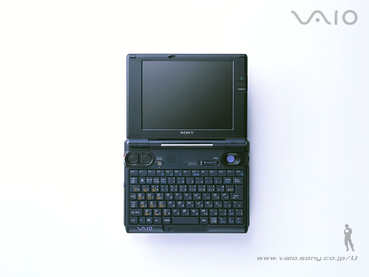PCG-U: Difference between revisions
More actions
Resident007 (talk | contribs) No edit summary |
Resident007 (talk | contribs) No edit summary |
||
| Line 3: | Line 3: | ||
The Sony VAIO PCG-U was a line of ultraportable subnotebooks sold by Sony from October 2002 to circa May 2004. All models in the line were never officially sold outside Japan. | The Sony VAIO PCG-U was a line of ultraportable subnotebooks sold by Sony from October 2002 to circa May 2004. All models in the line were never officially sold outside Japan. | ||
The first model, PCG-U1, was officially released on October 26, 2002. The higher-spec model, PCG-U3, was released in the same month. The final model, PCG-U101, was released in May of 2003. | The first model, PCG-U1, was officially released on October 26, 2002. The higher-spec model, PCG-U3, was released in the same month. The final model, PCG-U101, was released in May of 2003. | ||
Revision as of 18:32, 31 July 2024
Overview


The Sony VAIO PCG-U was a line of ultraportable subnotebooks sold by Sony from October 2002 to circa May 2004. All models in the line were never officially sold outside Japan.
The first model, PCG-U1, was officially released on October 26, 2002. The higher-spec model, PCG-U3, was released in the same month. The final model, PCG-U101, was released in May of 2003.
All PCG-U models had a ThumbPhrase feature, allowing one to easily type Japanese characters with one hand.
Despite the PCG-U1 and PCG-U3 both having considerably higher clock speeds than the PCG-U101, they are both far, far slower than the PCG-U101. The Intel Celeron M is able to be way faster in all usage scenarios due to being an actual x86 CPU instead of a VLIW (Very Long Instruction Word) one, like the Transmeta Crusoe.
The lineup was superseded by the completely redesigned VGN-U in May of 2004.
Detailed Specs
There was a total of three models in the PCG-U lineup. The PCG-U1 and U3 both share the same design, apart from the fact that the U1 is white and the U3 is black. The U3 was just an upgraded higher-specced and visually revised U1 with a faster CPU and more RAM.

One of the most interesting things about the PCG-U1 and PCG-U3 is their processor, the Transmeta Crusoe TM5800. While still running x86-based version of Windows and being able to run native x86 applications, this CPU is, in fact, a VLIW CPU which translates x86 instructions to VLIW instructions using the so-called Code Morphing Software and executes them on the fly. Thus, such CPU could emulate any CPU architecture unless the corresponding Code Morphing Software version exists. To speed up operation, a special cache for storing instructions is used, where the CPU stores the generated routines in cache and, if these routines are being frequently used, it tries to optimize them even further. However, this cache would be cleared after each reboot, meaning that the system would be pretty slow upon each boot and every "new" action (like starting a specific program the first time after booting the system) would also be slow as the CPU will need to optimize all the code from scratch. Apparently, the PCG-U1 has 16MB of cache, and the PCG-U3 has 24MB of cache for routines generated by Code Morphing Software.
However, while being not very fast, Transmeta CPUs were very power-efficient. While corresponding x86 CPUs could consume up to 35W of power under full load, the TM5800's power draw under full load was only 8.5W. The Transmeta CPU consumed even less power during tasks with medium to high intensity, like DVD playback (around 1.5W). This caused the U1 and U3 to work for around 3 hours on standard small battery pack and up to 12 hours on optional large battery pack.

PCG-U1
Processor: Transmeta Crusoe TM5800 867 MHz
Graphics: ATI Mobility Radeon M6 with 8 MB VRAM
Memory: 128MB
Display: 6.4" 1024×768
Storage: 20 GB 1.8-inch IDE HDD
Weight: 860g
MSRP: ¥150,000

PCG-U3
Processor: Transmeta Crusoe TM5800 933 MHz
Graphics: ATI Mobility Radeon M6 with 8 MB VRAM
Memory: 256MB
Display: 6.4" 1024×768
Storage: 20 GB 1.8-inch IDE HDD
Weight: 860g
MSRP: ¥150,000

PCG-U101
Processor: Intel Celeron M 600 MHz
Graphics: ATI Mobility Radeon M6 with 8 MB VRAM
Memory: 256MB
Display: 7.1" 1024×768
Storage: 30 GB 1.8-inch IDE HDD
Weight: 880g
MSRP: ¥160,000
Daily Usage Today
Even though they were pretty interesting machines for their size, all PCG-U models have little to no practical use nowadays. The CPU (especially Transmeta Crusoe found in PCG-U1 and PCG-U3) is far too slow to keep up with modern tasks, and RAM size doesn't allow for comfortable multitasking. The 1.8" HDD is also quite slow (it uses the same compact IDE interface as Apple's iPods, so spares are easy and cheap to find, as well as flash modding solutions, however even if you manage to install a fast drive, you will only see an increase in random access speeds, while linear speeds will still be limited by low bus speed). The slow keyboard and the fact that it's designed to be held like a handheld makes it hard for office use without external keyboard and mouse as well. However, you still can do very basic web browsing, but it is not going to be a very snappy experience.
However, PCG-U series is sought after by the collectors due to their unique CPUs (PCG-U1 and PCG-U3), very small footprint for the time of their release and appealing look. The fact that there were not many units produced and that PCG-U was only sold in Japan means that nowadays it's a quite rare item, and the prices have gone up pretty high.
Resources
Downloads
Credits
Sony, Wikipedia, and The Gadgeteer
